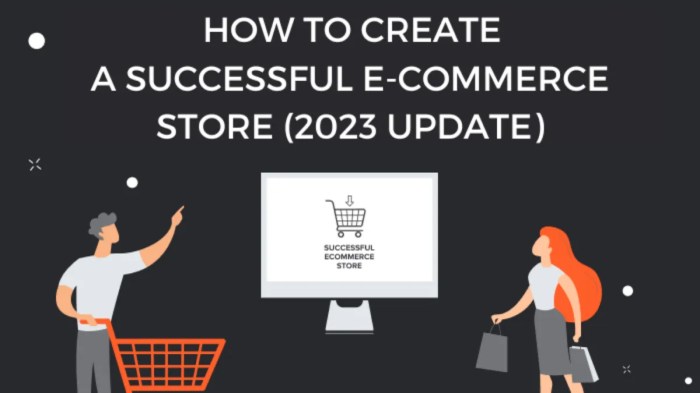Building a Successful E-commerce Store starts with laying the foundation for a thriving online business. From setting up your store to marketing strategies, this guide covers essential aspects to help you succeed in the competitive e-commerce landscape.
Get ready to dive into the world of e-commerce and discover the key elements that will set your online store up for success.
Setting Up Your E-commerce Store: Building A Successful E-commerce Store
Starting an e-commerce store requires careful planning and execution to ensure its success. Below are the essential steps to set up your e-commerce store and make it stand out in the digital market.
Choosing the Right E-commerce Platform
When setting up your e-commerce store, one of the most crucial decisions you’ll make is choosing the right e-commerce platform. Consider factors such as ease of use, customization options, scalability, and pricing. Popular e-commerce platforms like Shopify, WooCommerce, and BigCommerce offer a variety of features to help you build a successful online store.
- Shopify: Known for its user-friendly interface and extensive app store, Shopify is a popular choice for beginners and experienced e-commerce entrepreneurs alike.
- WooCommerce: If you’re already familiar with WordPress, WooCommerce seamlessly integrates with the platform, offering flexibility and customization options.
- BigCommerce: Ideal for growing businesses, BigCommerce provides advanced features like multi-channel selling and enterprise-grade security.
Choosing the right e-commerce platform can significantly impact the success of your online store.
Key Features for Designing Your Store
Designing your e-commerce store plays a crucial role in attracting and retaining customers. Consider the following key features when designing your store:
- Responsive Design: Ensure your store is mobile-friendly to cater to the increasing number of mobile shoppers.
- Intuitive Navigation: Make it easy for customers to find products and navigate through your store with clear categories and search functionality.
- High-Quality Images: Use high-resolution images to showcase your products and provide customers with a better shopping experience.
- Secure Payment Gateway: Implement a secure payment gateway to build trust with customers and protect their sensitive information.
- User Reviews and Testimonials: Display customer reviews and testimonials to build credibility and encourage purchase decisions.
By choosing the right e-commerce platform and implementing key design features, you can set up a successful e-commerce store that resonates with your target audience and drives sales.
Product Selection and Inventory Management
When it comes to building a successful e-commerce store, choosing the right products to sell is crucial. You want to offer items that are in demand, unique, and align with your brand’s identity. Here’s how to go about selecting the perfect products for your online store:
Choosing the Right Products
Effective inventory management is essential for the smooth operation of your e-commerce business. It involves keeping track of your stock levels, reordering products when needed, and ensuring that your product listings are accurate. Here are some strategies to help you manage your inventory efficiently:
- Utilize inventory management software to track stock levels in real-time and automate reordering processes.
- Regularly conduct inventory audits to identify slow-moving or obsolete products that need to be discounted or removed from your store.
- Implement a just-in-time inventory system to minimize storage costs and reduce the risk of overstocking.
- Establish relationships with reliable suppliers to ensure a steady supply of products and prevent stockouts.
Accurate product listings and stock levels are crucial for providing a positive shopping experience for your customers. When customers see that an item is out of stock or the product description does not match the actual product, it can lead to dissatisfaction and loss of trust in your brand. By maintaining up-to-date product information and inventory levels, you can avoid these issues and keep customers coming back for more.
Website Design and User Experience

Building a successful e-commerce store goes beyond just having great products, it also requires a well-designed website and a seamless user experience. Let’s dive into the key elements of a successful e-commerce website design and why user experience is crucial for driving sales.
Key Elements of Successful E-commerce Website Design
- Clear and Intuitive Navigation: Make it easy for customers to find what they are looking for with a simple and organized navigation menu.
- Visually Appealing Layout: Use high-quality images and a clean design to showcase your products effectively.
- Mobile Responsiveness: Ensure your website is optimized for mobile devices to reach customers on the go.
- Fast Loading Speed: Customers are impatient, so make sure your website loads quickly to prevent them from bouncing off.
- Secure Checkout Process: Build trust with your customers by providing a secure and seamless checkout experience.
Significance of User Experience in Driving Sales
User experience plays a crucial role in the success of an e-commerce store. A positive user experience can lead to higher conversion rates and repeat customers. By providing a seamless shopping experience, you can build trust with your customers and encourage them to make a purchase.
Optimizing Your Website for Mobile Responsiveness
With the increasing use of mobile devices for online shopping, it is essential to optimize your website for mobile responsiveness. This involves creating a responsive design that adapts to different screen sizes and ensures a seamless browsing experience for mobile users. By prioritizing mobile responsiveness, you can reach a wider audience and improve your chances of driving sales.
Marketing and Customer Acquisition
In order to successfully market your e-commerce store and attract customers, you need to implement a variety of strategies across different channels. Utilizing , social media, and email marketing can help you reach a wider audience and drive traffic to your online store. Creating a solid customer acquisition plan is essential for the growth of your business.
Strategy
- Optimize your website for relevant s to improve search engine rankings.
- Create high-quality, engaging content that aligns with your target audience’s interests.
- Build backlinks from reputable websites to increase your site’s credibility.
- Regularly monitor and analyze your performance to make necessary adjustments.
Social Media Marketing
- Establish a strong presence on popular social media platforms like Facebook, Instagram, and Twitter.
- Engage with your audience through interactive posts, stories, and live videos.
- Run targeted ads to reach specific demographics and increase brand awareness.
- Collaborate with influencers or brand ambassadors to promote your products to a wider audience.
Email Marketing Campaign
- Build an email list of potential customers by offering incentives like discounts or freebies.
- Create personalized and relevant email campaigns to keep customers engaged and informed about new products or promotions.
- Segment your email list based on customer behavior and preferences for better targeting.
- Track the performance of your email campaigns and optimize them for better results.
Payment Gateway Integration and Security

When it comes to running a successful e-commerce store, integrating secure payment gateways is crucial for both the business and its customers. A secure payment gateway ensures that all transactions on your platform are safe and protected from potential cyber threats.
Importance of Secure Payment Gateways
Having a secure payment gateway instills trust in your customers, encouraging them to make purchases without worrying about the safety of their personal and financial information. It also protects your business from fraud and chargebacks, ultimately leading to higher customer satisfaction and retention.
Different Payment Gateway Options
- PayPal: A widely used payment gateway that offers a seamless checkout experience and strong buyer protection.
- Stripe: Known for its flexibility, easy integration, and advanced security features.
- Authorize.Net: Offers a range of payment options and strong fraud prevention tools.
- Square: Ideal for small businesses with its user-friendly interface and transparent pricing.
Tips for Ensuring Transaction Security
- Use SSL encryption to protect customer data during transmission.
- Implement two-factor authentication for added security.
- Regularly update your payment gateway software to patch any vulnerabilities.
- Monitor transactions for any suspicious activity and have a response plan in place for potential security breaches.
Customer Service and Retention
Providing excellent customer service in e-commerce is crucial for building a successful online store. It not only helps in retaining existing customers but also in attracting new ones through positive word-of-mouth. Customer service plays a vital role in establishing brand loyalty and trust among consumers.
Strategies for Improving Customer Retention and Building Brand Loyalty, Building a Successful E-commerce Store
- Personalized Communication: Tailor your communication with customers based on their preferences and purchase history. This can include personalized emails, product recommendations, and special offers.
- Reward Programs: Implement loyalty programs that reward customers for their repeat business. This could be in the form of discounts, exclusive access to products, or points-based systems.
- Responsive Support: Ensure timely and helpful responses to customer inquiries and complaints. A quick resolution to issues can significantly impact customer satisfaction and loyalty.
- Feedback Mechanisms: Encourage customers to provide feedback through surveys, reviews, or ratings. Use this feedback to improve your products and services continuously.
Handling Customer Inquiries, Complaints, and Returns Effectively
- Establish Clear Policies: Clearly Artikel your return and refund policies on your website to set customer expectations upfront.
- Empower Your Team: Provide your customer service team with the necessary training and tools to handle inquiries and complaints effectively.
- Be Proactive: Anticipate potential issues and address them before they escalate. Proactive communication can help in resolving problems before they impact the customer experience.
- Resolve Quickly: Prioritize quick resolutions to customer issues to show that you value their time and business.
Analytics and Optimization
Data analytics plays a crucial role in optimizing an e-commerce store by providing valuable insights into customer behavior, sales performance, and overall website effectiveness. By analyzing data, businesses can make informed decisions to enhance user experience, increase conversions, and drive revenue growth.
Key Metrics to Track
- Conversion Rate: Measure the percentage of website visitors who make a purchase.
- Customer Acquisition Cost (CAC): Calculate how much it costs to acquire a new customer.
- Average Order Value (AOV): Determine the average amount customers spend per order.
- Cart Abandonment Rate: Track the number of users who add items to their cart but do not complete the purchase.
- Website Traffic Sources: Analyze where your traffic is coming from to optimize marketing efforts.
Tips for Optimization
- Regularly review and analyze data to identify trends and areas for improvement.
- Test different strategies such as pricing, promotions, and website design to optimize performance.
- Utilize A/B testing to compare the effectiveness of different variations and make data-driven decisions.
- Implement tracking tools like Google Analytics to monitor key metrics and performance indicators.
- Engage with customers through surveys and feedback to understand their preferences and pain points.